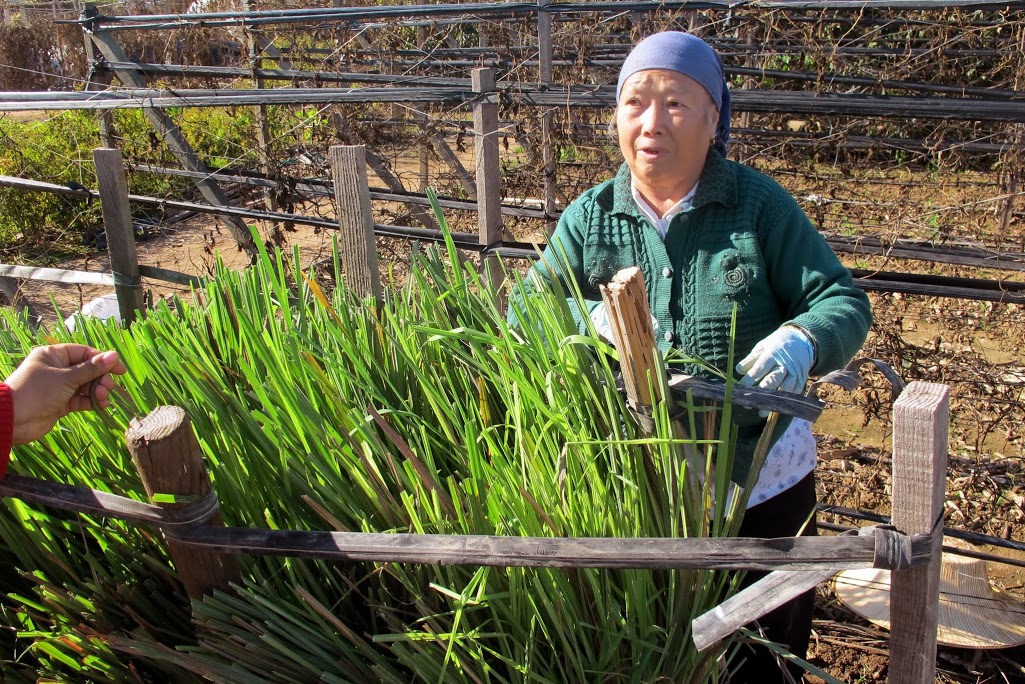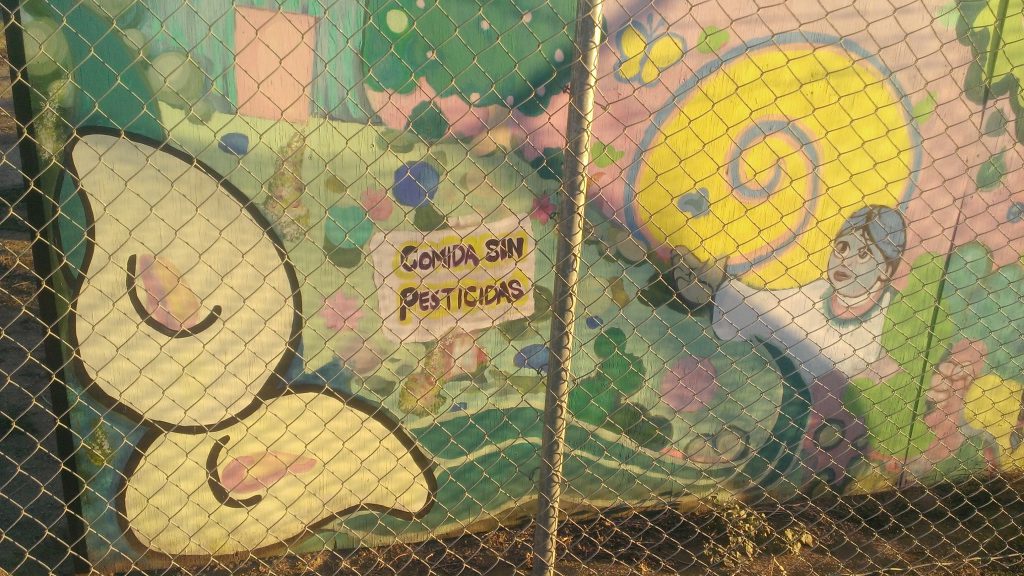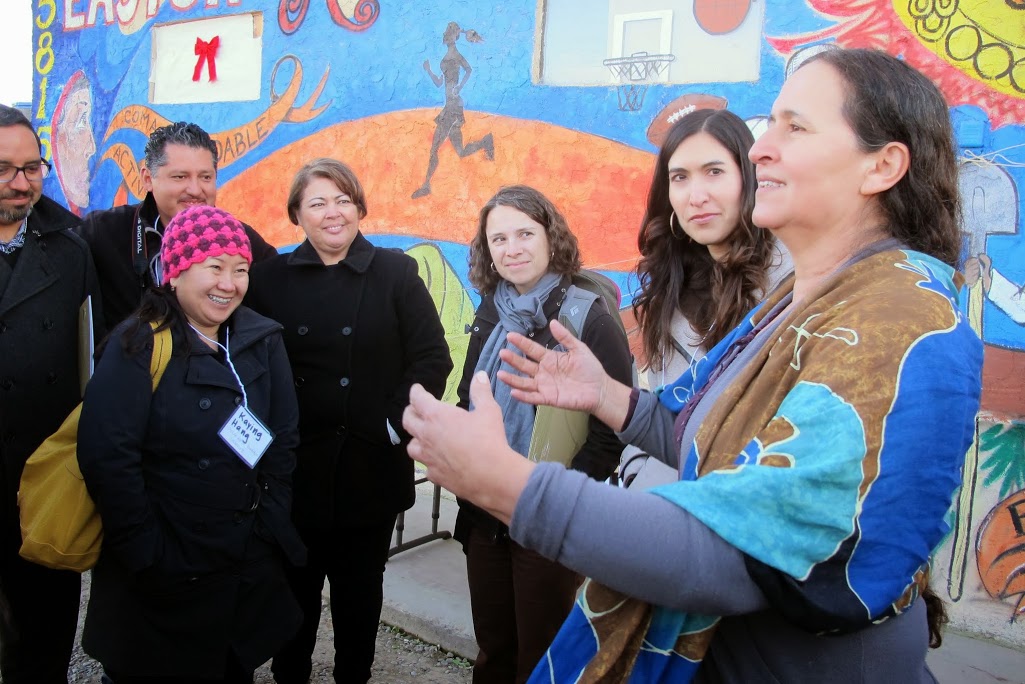This post was authored by Kathy Sessions, with contributions from the Convergence Partnership, the Funders’ Network for Smart Growth and Livable Communities, Grantmakers Concerned with Immigrants and Refugees, Grantmakers In Health, and the Sustainable Agriculture and Food Systems Funders.
In California’s San Joaquin Valley, the severity of the region’s problems are matched only by the inspiring, innovative work being done to enable everyone in the region to have a healthier life, cleaner environment, economic opportunity, fair treatment and thriving communities.
Six funder groups jointly hosted a funder tour on December 4-6, “Exploring the San Joaquin Valley: A Land of Change and Promise” from a base in Fresno, California. The cosponsors included the Convergence Partnership (CP), the Funders’ Network for Smart Growth and Livable Communities (TFN), Grantmakers Concerned With Immigrants and Refugees (GCIR), Grantmakers In Health (GIH), the Health and Environmental Funders Network (HEFN), and the Sustainable Agriculture and Food Systems Funders (SAFSF).
Back in June, the cosponsors shared our hopes that this joint event could help funders with different issue interests learn more holistically about regional challenges – and explore ways philanthropy could respond with more effective regional support.
After the tour, I asked my colleagues from the cosponsoring groups to reflect on the event. Here are some highlights, from all of us to all of you.
One clear takeaway was the value of exploring the Valley without narrow issue boundaries. Many regional challenges are interconnected, as are people and groups working to solve them. We learned a lot, from one another and especially from the speakers and guides from the Valley.
Agriculture and food issues set the stage — no surprise given the region’s economy is dominated by industrial agriculture. Susie DiMauro (SAFSF) commented that a panel pairing an organic farmer and an advocate for water quality “highlighted commonalities between agriculture, water, and environmental justice interests, and ways in which agribusiness and activists may work toward collaborative solutions. “ An evening presentation by Dr. Glenda Humiston, USDA’s state director of California Rural Development, also highlighted possibilities for regional public-private funder partnerships.

We learned both about the Valley’s widespread food insecurity and efforts to improve access to healthy foods. As Nina Bohlen (TFN) put it, “It is unconscionable that in one of the most productive agricultural regions in the world, so many go to bed hungry or aren’t sure if they can feed their families.” One group visited the proposed site of an urban agricultural park and witnessed Hmong American farmers working in their community gardens. Another went to a small local store in rural Easton which is receiving pilot funding to sell fresh fruits and vegetables from local farms and to provide incentives for shoppers.
Issues of immigration reform, education and youth leadership surfaced from discussions about the Valley’s people and farmworking communities. Camellia Rodriguez Sack-Byrne (GCIR) recalled the “powerful testimony” of youth organizer Gelasio Rodriguez with Fresno Immigrant Youth in Action “who conveyed the struggles, sacrifice, and resilience of a young immigrant from a mixed-status family in the Valley.”
Environmental conditions and impacts were a key focus. Ryan Van Lenning (TFN) said, “Many of us had heard about the poor air quality and poor water quality in the San Joaquin Valley. But we did not realize how bad the situation really was and were shocked to learn about the cumulative health impacts that this creates for residents of low-income communities.”
Colin Pekruhn (GIH) recalled a “visit to Addams Elementary School in West Fresno, where children are subjected to an enormously challenging learning environment, consisting of poor air quality, noise pollution, and a lack of sidewalks and crosswalks.”

From HEFN, I was particularly gratified to hear from a community-academic partnership that, with HEFN members’ support, mapped out the Valley to identify neighborhoods with concentrations of environmental hazards, poverty and vulnerable populations. Their findings have strengthened advocacy for healthier conditions, and their methodology has helped spur a new California Environmental Health Screening Tool to help target resources to overburdened communities.
We also learned that the Valley is one of the fastest growing regions in the state. Influencing this growth can help to preserve prime agricultural lands and open space, reduce greenhouse gas emissions, and promote reinvestment in impoverished communities. Stephanie Boarden (CP) cited a presentation about work under California’s Sustainable Communities and Climate Protection Act as a prime example of equity advocacy “by addressing the intersection in low-income communities and communities of color between health and the built environment (transit, housing, land use).”
The tour generated a lot of interest in further engagement, investment, and continued learning together.
Several participants flagged interest in more sustained investment in leadership development. As Stephanie (CP) noted, support for leadership-building intermediaries “builds local capacity, is a powerful tool for influencing local policy, and creates leadership that outlives the life of the funding.” Colin (GIH) likewise commented that projects funded for low-income health work have helped “empower and equip leaders who now are tackling other issues impacting the health of the community, such as education, the environment, and transportation.”
Many echoed a sense that great work and strong local assets already are in place in the Valley; more funding for worthy work underway, rather than new strategies, may be most helpful. Several participants including the Fresno Regional Foundation flagged a willingness to serve as regional partners for joint funding. Other participants based in or around San Francisco are exploring possibilities for meeting and/or organizing a Bay-area event for funders focused on the Valley.

Nina (TFN) commented on the “courage and persistence of low income residents and their sophisticated organizing throughout the Valley (whether about general plan updates, pesticides, or toxic waste dumps) with little resources.” She flagged opportunities for “sustained investment for community organizing (on issues like environmental justice, smart growth, and clean water) as well as in educating decision-makers and seeding new forms of ownership such as worker coops and community land trusts.
Camellia (GCIR) plugged a Central Valley DACA initiative as an important ongoing opportunity to help undocumented youth and planning for possible immigration reform underway in the Valley. GCIR invites funders to “continue the conversation about immigration and immigrant integration, particularly in rural areas, at GCIR’s California Immigrant Integration Initiative (CIII) funders’ table” which meets quarterly, and/or at its national convening (May 20-22, 2014, Nashville). GCIR also has funder resources and suggestions for further reading, including a report on indigenous farmworkers by Centro Binacional para el Desarollo Indígena Oaxaqueño.
The Convergence Partnership plans to report back to its members about opportunities for investing in equity-focused advocacy in the Valley. The Convergence Partnership and GIH each have resources for funders focused on issues of healthy food access and other determinants of health in the Valley.
HEFN and its members supporting “cumulative impact” work will continue to advance the development and uses of these environmental health screening tools in advocacy and decision-making. HEFN and its working group of funders concerned about impacts of hydraulic fracturing in the Valley also invite questions or participation from Valley-focused funders concerned about impacts of fracking on the Valley’s lands, health, air and water quality, and communities.
TFN is raising funds to hire a funder coordinator to be based in the San Joaquin Valley. The coordinator will support a working group of funders interested in learning, collaborating, and investing in the Valley. TFN invites funders to participate in the working group, and plans to have resources available for funders interested in learning about current efforts to create healthier, more equitable communities in the Valley. TFN is also interested in continuing to collaborate with other funder affinity groups.
SAFSF plans to follow up with SAFSF members who attended the funder tour, highlight the event in their year-end report, and continue to engage with other affinity groups to foster continued learning. As Susie DiMauro (SAFSF) put it, “The rich conversations that grew out of the funder tour emphasize that, while this sort of interdisciplinary, cross-sector, and place-based learning may be complicated and challenging to put together, it yields important and rewarding results. “
The tour agenda, resources, and several presentations will be posted soon at www.safsf.org.
Many thanks to the sponsors, participants, and resource people for this funder tour. For more information from sponsors, contact:
- Convergence Partnership: Stephanie Boarden, PolicyLink, Stephanie@policylink.org
- Funders’ Network for Smart Growth and Livable Communities: Nina Bohlen, ninabohlen@fastmail.net
- Grantmakers Concerned With Immigrants and Refugees: Camellia Rodriguez-SackByrne, camellia@gcir.org
- Grantmakers In Health: Colin Pekruhn, cpekruhn@gih.org
- Health and Environmental Funders Network: Kathy Sessions, ksessions@hefn.org
- Sustainable Agriculture and Food Systems Funders: Virginia Clarke, vclarke@safsf.org

